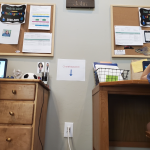Which teaching model best serves students in a pandemic? This year has shown that there is not a one size fits all model for teaching in a pandemic and that no matter which learning model you have chosen there are benefits and drawbacks. This year I have taught students online for two quarters, nine days of in-person learning (to read more about my experience with that click here and here), and now am teaching in-person students and online students simultaneously in what we are calling a hybrid model. Here is what I have found to be the pros and cons of each:
Online
When the spread of COVID-19 was high in our community, my school district elected an online learning model for all students. This was designed to keep our students and teachers safe and to slow the spread of the virus. I taught the first quarter, part of the second quarter, and third quarter online this school year.
Pros – Students are safe from contracting COVID-19 at school
Cons – Students may not have the support they need for learning online at home. Parents may be working from home, trying to keep their own jobs, and are not available to help their child as their child needs throughout the day. There may be younger siblings who are loud and distracting, and some students may be told by their parents to care for their younger siblings while the parents themselves are trying to work from home. Internet connections may be slow, which makes learning through Google Meet or Zoom difficult.
In conclusion, while online learning was the safest choice here, it was not ideal for my first grade students.
In-Person
When the spread of COVID-19 slowed and the numbers in our community were low, my school district presented parents with an option for their child to return to in-person learning. A third of students in my grade level stayed online, and my team and I reconfigured the groups of students so one class would stay exclusively online, while two other classes returned with a full group of students in person. For my class, this model lasted nine days.
Pros – Students are in school and in an environment made for learning. Classrooms are quiet when needed, collaborative when appropriate, and students have their own space ready for learning. Teachers are providing instruction and engaging students in their learning and can answer questions students have in a timely manner to allow students to complete and submit work.
Cons – Students spend a lot of time washing their hands, which with 25 first graders totaled an hour a day. Washing hands frequently for 20 seconds is a mitigation strategy to allow us to return to in-person learning safely so we will continue to follow this rule as directed, but it is extremely time-consuming. Students have a lot of extra rules to follow so that we can implement the recommended mitigation strategies, which takes extra time to teach and reinforce these guidelines.
In conclusion, it was a rough nine days back in the classroom with 25 students for in-person learning.
Hybrid
I have been teaching students in a hybrid model since we returned from Spring Break on March 15, 2021. About a third of students have elected to remain online, but due to the challenges of sharing many students between teachers and spacing out so many students in class, we have decided to keep our rosters. I have the majority of students that I have had since the beginning of the year. Some of these students are in the physical classroom space with me, while others are online. I have three students from another teacher’s roster in my classroom during the day to keep the number of students in-person comparable, which so far is proving to be easier to manage than distributing 25 students between two teachers.
Pros – My students who have been with me have figured out the routines that we do each day, where to find assignments, and how to ask for help when needed. I currently have 15 students in-person and 11 students online, which is bringing our time washing our hands down significantly. Students can be spaced out more in class, and in-person students receive more attention from their teachers and peers.
Cons – While my online students receive help and guidance from me, it is not the same as when everyone was online. Often I am not in the camera, or if I am in view of the camera I am not facing it since I am teaching my students in person. Students in-person are receiving priority when questions need to be answered, so my online learners are having to be patient while they wait for me to return to the screen to help them.
In conclusion, my students and I are happier with this model. I do not know if it is the best option, and while it is still extremely stressful and difficult and certainly still has its flaws, but it has been the most manageable so far.
Is the grass greener on the other side? What have your experiences been teaching in different modalities been like this year?










Comments 2
Caitlin, great summary of the pros and cons of the teaching models that this pandemic has led us to and through. I agree that there are definitely pros and cons to each teaching model. I am currently teaching the remote section of second grade and my colleauges have the other two second grade sections in-person. For me, I feel like we have finally hit a groove where students are growing more responsible, know how to get help from me when needed and I have finally gotten the hang of differentiating in the virtual world to meet my students where they’re at. I definitely miss teaching in person and think there is so much more long term planning involved with teaching remotely. One con we have run into is that there were significantly more students wanting to return in person. This means that I have a small class size (which is nice), bu tmy colleauges and dear friends have much bigger class sizes. Overall, I think teachers everywhere have done such a good job being flexible, adaptable, and doing all they can to support students!
This is a great discussion of the pros and cons of each of the COVID teaching models. My attention was drawn to your reflections on your Hybrid Model (we call it Concurrent in my district). This model has been incredibly challenging for many of our teachers. They have really struggled with feeling like they aren’t serving either of the groups well. I was encouraged by your positive perspective on teaching both groups at the same time. You’re right, there are some positives that need to be focused on. Thank you!